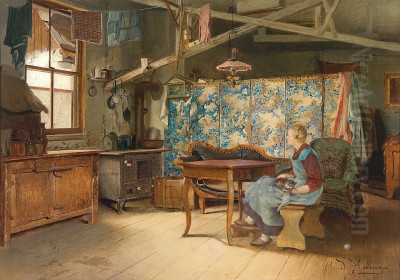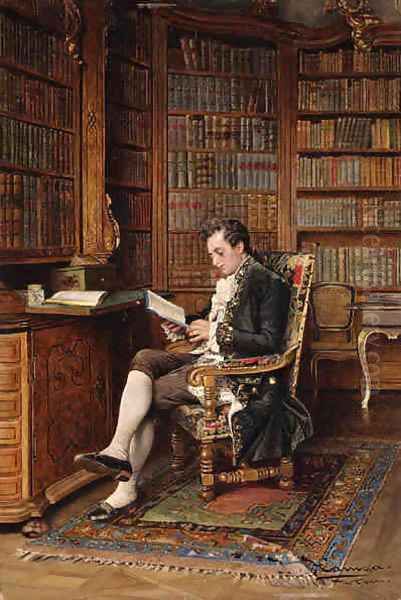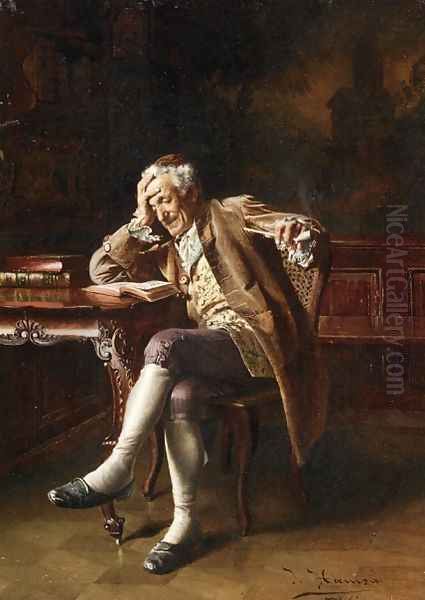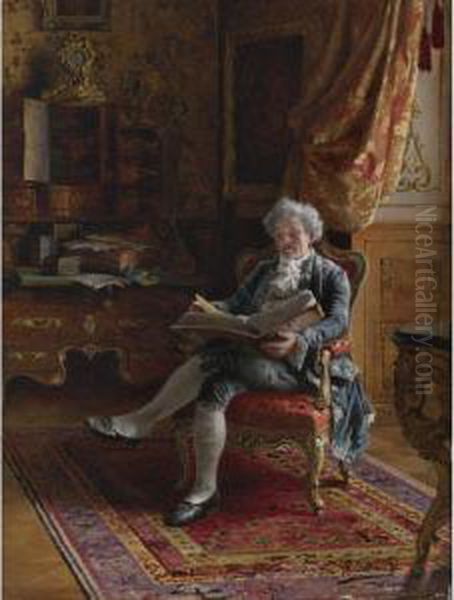Introduction

Johann Hamza stands as a significant figure in the realm of Viennese genre painting during the late 19th and early 20th centuries. Born in Kostelní Myslová, now part of the Czech Republic, on June 21, 1848, Hamza dedicated his artistic career to capturing the intricate details of life, particularly focusing on the social customs and environments of Vienna's affluent bourgeoisie. His work is characterized by meticulous detail, a refined technique, and a nostalgic charm that evokes the elegance and leisure of a bygone era. He passed away in Vienna in 1927, leaving behind a legacy of paintings admired for their narrative quality and exquisite execution.
Early Life and Artistic Formation
Johann Hamza's journey into the art world began in Kostelní Myslová. It is noteworthy that while some sources erroneously cite his birth year as 1850, reliable records confirm his birth on June 21, 1848. Seeking formal artistic training, Hamza enrolled at the prestigious Academy of Fine Arts Vienna. This institution was a central hub for artistic education within the Austro-Hungarian Empire, shaping the careers of many notable artists.
During his time at the Academy, Hamza had the distinct privilege of studying under Professor Eduard von Engerth (1818-1897). Engerth was himself a respected artist, known primarily as a painter of historical subjects, architectural themes, and portraits. Studying under such a master undoubtedly provided Hamza with a strong foundation in academic drawing and painting techniques, emphasizing precision and careful composition, elements that would become hallmarks of Hamza's own mature style. This rigorous training prepared him well for his future specialization in genre scenes.
Artistic Style and Influences
Johann Hamza is primarily classified as a genre painter, an artist who depicts scenes of everyday life. His work firmly belongs to the Viennese traditional painting school, which upheld academic standards of representation and finish, often looking back to earlier periods for inspiration. Hamza developed a distinctive style marked by an extraordinary attention to detail. He rendered textures, fabrics, furniture, and architectural elements with remarkable precision, creating visually rich and immersive scenes.

His paintings often feature elaborate interior settings, meticulously depicting the luxurious furnishings popular among Vienna's upper classes. References in descriptions of his work mention both Biedermeier-style elements (or perhaps more accurately, Historicism drawing on Biedermeier) and later, Victorian revival styles, reflecting the fashionable tastes of the era he portrayed. Beyond the physical setting, Hamza excelled at capturing the subtle nuances of human expression and interaction, bringing his characters and their stories to life within the carefully constructed environments.
Hamza's approach was significantly influenced by the masters of the Dutch Golden Age, such as Johannes Vermeer or Pieter de Hooch, whose intimate interior scenes and mastery of light resonated with Hamza's own interests. He also drew inspiration from 18th-century European masters, perhaps finding echoes in the elegant compositions and refined subject matter of artists like Jean-Antoine Watteau or Jean-Honoré Fragonard. Hamza synthesized these influences with his personal dedication to detail and his ability to recreate a specific historical or social atmosphere, often imbuing his scenes with a sense of romanticism and nostalgia.
Themes and Subject Matter
The core of Johann Hamza's oeuvre revolves around the depiction of Viennese society, particularly the lives of the wealthy bourgeoisie and glimpses into aristocratic fantasy. He avoided grand historical or mythological narratives, preferring instead the intimate scale of everyday occurrences and social rituals. His canvases frequently portray elegant figures engaged in leisurely pursuits within opulent domestic interiors, salons, or sometimes, more specific settings like churches during weddings.
A particularly notable and recurring theme in Hamza's work is the library or study. He painted multiple works exploring this subject, with titles such as "In the Library," "An Old Man Reading," "Reading for Pleasure," and "Reading on the Terrace." These paintings typically feature gentlemen, often solitary figures, absorbed in the act of reading amidst shelves laden with books. These scenes not only showcase his skill in rendering detailed interiors but also reflect the cultural value placed on literacy and intellectual pursuits within the society he depicted.
Other common subjects include social gatherings, musical interludes, quiet domestic moments, and ceremonial events like weddings. Through these varied themes, Hamza consistently focused on capturing the material culture, social etiquette, and prevailing atmosphere of upper-class Viennese life in the late 19th century. His works serve as detailed visual documents of this specific milieu, presented with technical finesse and a gentle, often idealized, perspective.
Exhibitions and Recognition

Johann Hamza achieved considerable recognition during his lifetime, showcasing his work in prominent artistic centers. Between 1879 and 1890, his paintings were exhibited in major cities including Vienna, Dresden, and Munich. These exhibitions exposed his work to a wider audience and helped establish his reputation as a skilled genre painter. His participation in these shows indicates his active engagement with the contemporary art world of Central Europe.
His renown extended beyond German-speaking lands. A significant milestone in his career occurred in 1891 when he exhibited his work in London. This international exposure was met with acclaim, culminating in Hamza being awarded a prestigious gold medal for his painting. This award underscored the appeal of his detailed style and engaging subject matter to audiences outside of Austria-Hungary.
The meticulous craftsmanship and charming subjects of Hamza's paintings proved popular not only in exhibitions but also with private collectors and the art market. His works were sought after by collectors in Vienna, Germany, the United States, and the United Kingdom. This commercial success further solidified his standing as a leading genre painter of his time, whose art resonated with the tastes of the affluent consumers who often saw their own lifestyles reflected, albeit perhaps idealized, in his canvases.
Artistic Context and Contemporaries
Johann Hamza operated within the vibrant artistic environment of late 19th-century Vienna, the capital of the Austro-Hungarian Empire and a major European cultural hub. His training at the Academy of Fine Arts Vienna placed him within the established institutional framework of the city's art scene. His teacher, Eduard von Engerth, was a prominent figure associated with the Academy. While the provided sources state there are no specific records detailing Hamza's direct interactions or collaborations with many other specific artists, it is highly probable that he was aware of, and likely interacted with, numerous contemporaries within Vienna's relatively close-knit art community.

The artistic landscape of Vienna during Hamza's active years was diverse. While Hamza represented the continuation of traditional, academic genre painting, Vienna was also becoming a center for emerging modern art movements. Figures associated with the more traditional or established academic circles, potentially overlapping with Hamza's time or influence, included the immensely popular Hans Makart (though his peak was slightly earlier), and other Academy professors or respected painters like Carl von Blaas or Leopold Carl Müller. Genre painting itself had a strong tradition in Vienna, with earlier influential figures like Ferdinand Georg Waldmüller and Biedermeier artists such as Carl Schindler paving the way. Rudolf von Alt, famous for his cityscapes and detailed interiors, was another prominent contemporary.
Hamza's adherence to detailed realism and historical settings contrasted sharply with the radical innovations being introduced by the Vienna Secession movement, founded in 1897 by artists like Gustav Klimt, Koloman Moser, and later associated with figures like Egon Schiele. While Hamza was not part of this avant-garde movement, his traditional style represented the established artistic current against which the Secessionists rebelled. His work, influenced by Dutch Golden Age masters like Vermeer and 18th-century painters like Fragonard, maintained its appeal to a segment of the public and collectors who valued craftsmanship and nostalgic themes over modernist experimentation. His son, Hans Hamza, also became a painter in Vienna, continuing in a similar artistic vein.
Legacy and Conclusion
Johann Hamza passed away in Vienna on December 22, 1927. He leaves behind a body of work that serves as a detailed and evocative chronicle of Viennese upper-class life during the late Habsburg era. As a prominent member of the Viennese traditional painting school, he distinguished himself through his exceptional technical skill, meticulous attention to detail, and his focus on intimate genre scenes. His paintings, particularly those set in libraries or depicting social rituals, offer valuable visual insights into the customs, interiors, and atmosphere of his time.
While perhaps overshadowed in art historical narratives by the more revolutionary modern artists emerging in Vienna during his later career, Hamza enjoyed significant success and recognition during his lifetime. His works were widely exhibited and collected internationally, attesting to the broad appeal of his refined style and engaging subject matter. He successfully captured a sense of elegance, leisure, and romantic nostalgia that resonated with contemporary audiences and continues to attract admirers today. His son, Hans Hamza, carried forward a similar artistic sensibility, further cementing the family name's association with Viennese genre painting. Johann Hamza remains an important representative of late 19th-century academic genre painting, a master craftsman whose canvases meticulously preserve moments from a specific stratum of Viennese society.